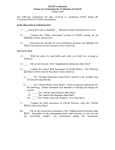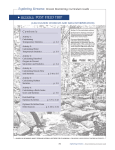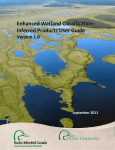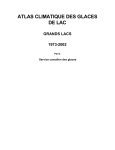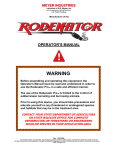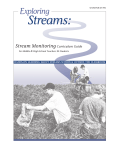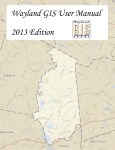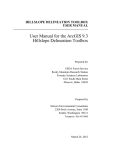Download wisconsin ephemeral ponds project march, 2008 an invitation to
Transcript
WISCONSIN EPHEMERAL PONDS PROJECT EPHEMERAL POND MONITORING INVITATION SURVEY METHODOLOGY AND PROTOCOL MARCH, 2008 AN INVITATION TO PARTICIPATE IN MONITORING EPHEMERAL PONDS ..............................2 EPHEMERAL POND (VERNAL POOL) WEBSITES .............................................................3 EPHEMERAL POND MONITORING PREPARATION ............................................................4 SURVEYING AN EPHEMERAL POND ..............................................................................5 EPHEMERAL POND OBSERVATION FORM EXAMPLE……………………………………………8 EPHEMERAL POND OBSERVATION FORM INSTRUCTIONS .............................................. 10 APPENDIX A. RECOMMENDED AND OPTIONAL EQUIPMENT ............................................ 10 APPENDIX B. ELEVATION VIEW OF A HYPOTHETICAL POND BASIN ................................ 10 APPENDIX C. POND SURVEY SETUP .......................................................................... 10 APPENDIX D. CITIZEN MONITORING LEVELS. .............................................................. 10 Partial Funding Provided By: 04/04/2008 WISCONSIN EPHEMERAL PONDS PROJECT An Invitation to Participate in Monitoring Ephemeral Ponds The Wisconsin Ephemeral Ponds Project (WEPP) was initiated in the spring of 2006 through the collective efforts of individuals from government, the University of Wisconsin, non-profit organizations, and others committed to wetland conservation. A goal of this project is to collect information about the location and status of ephemeral ponds as habitat for amphibians and other wildlife in order to help protect this poorly understood ecological community type for future generations. Ephemeral ponds are isolated wetlands that temporarily hold water during spring and early summer after snow-melt or heavy rains but dry up by mid to late summer or early fall. They generally lack a connection with permanent streams and waterways. In other words, they have no inlets or outlets. They are typically free of breeding fish, but provide a unique and vital breeding habitat for specialized amphibians and invertebrates, as well as a variety of wetland plant species. For additional information on the geography and ecology of ephemeral ponds, which are also known as vernal or seasonal pools, please explore the internet websites listed on the back of this page. WEPP is seeking assistance from groups and individuals to locate, map, and inventory Wisconsin’s difficult-to-find ephemeral ponds. Groups such as nature centers, schools, colleges, and conservation organizations are invited to participate as Ephemeral Pond Partners by including the WEPP Citizen Monitoring methods within their programs. WEPP also welcomes individual Citizen Monitors who will be matched with a local group if needed for additional support. As a volunteer in the network you will be asked to collect information at sites WEPP coordinators have mapped as “potential ephemeral ponds and also for areas you suspect to be ephemeral ponds using the broad definition of an ephemeral pond listed above. Information that you collect will allow WEPP Coordinators to better identify and understand this important wetland habitat type in southeast Wisconsin. In the future the hope is to expand the WEPP monitoring network to other parts of the state. The type of information you will be asked to collect is presented in the example pond monitoring survey form (pages 8-9) and described in detail in the instructions section (pages 10-22) For information on becoming an Ephemeral Pond Partner or Citizen Monitor for the Ephemeral Pond Monitoring Network, please contact Gail Epping Overholt, WEPP Volunteer Coordinator: (414) 290-2434. For general questions about the Wisconsin Ephemeral Pond Project please contact Tom Bernthal, WEPP Project Manager, WDNR, P.O. Box 7921, 101 South Webster Street, Madison, WI 53707, Phone: (608) 266-3033. Partial Funding Provided By: 04/04/2008 Page 2 Ephemeral Pond and Vernal Pool Websites The following list of websites provides links to federal, state, and non-profit organizations involved in the study of ephemeral ponds. This list is far from exhaustive! Please refer to these to acquire a better understanding of the occurrence of ephemeral ponds across North America, and for information aiding the identification of the plants and wildlife that benefit from these ecologically important wetlands. Please go to the Wisconsin’s Citizen-based Water Monitoring Network and the Wisconsin Wetlands Association websites to learn more about participating as a citizen monitor for ephemeral ponds, their ecology and how to help protect them. Wisconsin’s Citizen-based Water Monitoring Network: http://watermonitoring.uwex.edu/level3/WIephemeral.htm Wisconsin Wetlands Association: http://www.wisconsinwetlands.org/SeasonalBasin.htm Federal Agencies: USDA Forest Service – Ecology of Woodland Vernal Pools http://www.fs.fed.us/ne/amherst/projects/vernal.html US Environmental Protection Agency (EPA) – Vernal Pool Indicators http://www.epa.gov/bioiweb1/html/vernal_pool_indicators.html US Geological Survey (USGS) – Amphibian Research and Monitoring Initiative (ARMI) http://armi.usgs.gov/ State Agencies: Massachusetts Division of Fisheries and Wildlife – Vernal Pools http://www.mass.gov/dfwele/dfw/nhesp/vernal_pools/vernal_pools.htm New Jersey Division of Fish and Wildlife – New Jersey’s Vernal Pools http://www.state.nj.us/dep/fgw/ensp/vernalpool.htm Virginia’s Vernal Pools – Seasons in the Life of Vernal Pools http://www.lynchburgbiz.com/virginiasvernalpools/index.html Wisconsin Department of Natural Resources – Natural Communities of Wisconsin http://dnr.wi.gov/org/land/er/communities Non-profit Organizations: California Vernal Pools – A Collection of Information and Resources http://www.vernalpools.org/non-california.htm Ohio Vernal Pool Partnership http://www.ovpp.org/ Ontario Vernal Pool Association http://www.ontariovernalpools.org/ Vernal Pool Association http://www.vernalpool.org/vernal_1.htm Partial Funding Provided By: 04/04/2008 Page 3 WEPP Invitation, Methods & Protocol Ephemeral Pond Monitoring Preparation To successfully conduct an ephemeral pond survey, you need to be well organized before you head to the field. Be sure to consider your safety, and what steps you will need follow to conduct the survey. The following check-list of items to consider prior to conducting an ephemeral pond survey should help make your survey successful: I. When to Survey A minimum of three surveys should be conducted for any mapped site that has NOT been ruled out as a potential ephemeral pond (PEP). Additional surveys are useful especially to determine more precisely when the ponds dry and to make additional plant and animal observations. Table 1 lists guidelines for when to conduct surveys. These guidelines present four seasonal periods in which to distribute site surveys across the growing season. The first three are related to the timing of when different species of amphibians are most easily observed or detected. Plan to schedule the first survey during early spring, the second during late spring, and the 3rd during summer. A fourth survey may be helpful during late summer or early fall if the pond still has water during the third visit. For any site, if the 1st survey period is missed, you can still conduct surveys during any of the later periods. Meeting the ‘minimum water temperature’ guidelines increase the likelihood of detecting frogs and toads by their calls rather than relying only on visual observation. Note: Water temperature changes much more slowly than air temperature, so after a few warm days the water temperature in the pond may exceed the minimum in Table 1 even if the air temperature doesn’t. Table 1. Survey Period Guidelines Survey Period Range of Dates Minimum Water Temperature Early Spring April 1 – 30 50 F Late Spring May 20 – June 5 60 F Summer July 1 – 15 Late Summer/Fall August –September Purpose o Document adult salamander and fairy shrimp occurrence, maximum depth o Document amphibian and invertebrate occurrence, hydrology 70 F o Document amphibian and invertebrate occurrence, hydrology, canopy cover No minimum Document hydrology, basin condition Ideally, the season’s first survey should occur at the spring thaw when adult salamanders are migrating to ponds for breeding. Peak conditions generally coincide with first warm spring rains that occur after the ground has thawed and the edges of most ponds contain melted ice-water or the pond is entirely open. A local nature center in your area can provide advice on when these conditions are expected to occur during a particular year. II. Before departing for site (i.e., at nature center, home, or other location) A. Assemble necessary equipment, forms and notebooks B. Acquire maps/directions 04/04/2008 Page 4 WEPP Invitation, Methods & Protocol C. Obtain permission from landowner(s) to access the ephemeral pond site(s) where you will conduct the survey D. Inform someone else of your field work schedule and location III. In parking area or place to begin hike into pond A. Evaluate your personal safety prior to approaching the pond area. Consider: 1. Weather (lightening, flash floods, high winds) 2. Orientation; provide a description of route, destination, and time on car dash 3. Human-use activities (e.g., hunting, logging, other activity that may hamper the survey) 4. Personal health (i.e., is your health limiting in any way?) B. Prepare all necessary equipment and forms prior to approaching the pond area. 1. Fill in date, location, observers, pond ID 2. Make compass and map(s) or photo of area easily accessible 3. Calibrate electronic meters, activate GPS and fix vehicle waypoint, confirm good batteries 4. Protect equipment and form from the weather 5. Clean equipment after each survey at site/parking area (to help minimize spread of invasive species) C. If multiple people are involved, identify a team leader and delegate survey tasks/responsibilities to individuals/teams. Surveying an Ephemeral Pond I. En route to pond after leaving vehicle A. Initial Survey: 1. Once you are within about a football field’s length (~300 m) from the pond, move quietly and slowly while frequently stopping to scan for animals, plants, and land-use changes associated with the pond. Use binoculars to make these observations from a distance if you have them available. 2. Listen for sounds of birds, frogs, and mammals coming from the pond area 3. Record your observations on the data form or in a field book II. On arriving at the pond edge A. Assemble your group and equipment in secure area near pond edge 1. Avoid hazardous settings (e.g., under dead overhangs or poison ivy patch) 2. Avoid areas prone to erosion 3. Avoid areas representing potential rare flora or animal use B. Re-evaluate initial plan to ensure the safety of team members and success of the survey. 04/04/2008 Page 5 WEPP Invitation, Methods & Protocol 1. Re-assign tasks/responsibilities if necessary 2. Abandon survey if necessary (e.g., unsafe human activities nearby, weather change, presence of breeding threatened or endangered bird species) III. Conducting the Pond Survey Ephemeral ponds are fragile environments. Many amphibians and invertebrates are very sensitive to the effects of disturbance to water and/or the vegetation surrounding/within the pond. When conducting survey work in the pond, PLEASE walk very carefully to minimize the amount of disturbance to sediments and vegetation. Always watch ahead in the water so you don’t disturb amphibian adults or their eggs or emerging aquatic invertebrates, which are often attached to vegetation just above or below the water’s surface. Pets should not be allowed to enter the pond basin or walk along its edge, which is the most sensitive area. Note: The “basin” of the pond is the entire depression that the pond could fill when the water level is highest. The basin may extend beyond the ponded area, depending on the level of water at the time of your survey. 1) Complete terrestrial component of survey 9 Assess weather conditions and time 9 Develop a pond sketch, including describing land-cover and disturbance 2) Complete amphibian and macroinvertebrate survey 9 Search pond areas for amphibian evidence 9 Search substrate, open water and vegetated areas for macroinvertebrates 3) Monitor water quality 9 Collect surface and bottom water temperature 9 Collect pH, Dissolved Oxygen (DO), and conductivity measures (optional) 9 Assess water color and clarity 4) Record basic structural features 9 Measure current maximum water depth within the basin or, if the pond is dry, assess substrate moisture 9 Measure width and depth of basin at high-water mark 9 Assess % canopy cover and % cover of water vs. exposed bottom 9 Determine if the pond is connected to other wetlands and/or streams 5) Complete plant community/basin structure assessment 9 Determine dominant plant species (if possible) and the plant community within the basin 9 Determine the percent cover of each plant community type 9 Describe the plant community within 30 m of the pond (optional). 9 Complete soil profile assessment once after pond dries (optional). 04/04/2008 Page 6 WEPP Invitation, Methods & Protocol IV. Additional Observations Record any additional observations that can help characterize the landscape at and surrounding the pond. These observations should be recorded in a field book and/or on an additional sheet of paper to accompany the data form. Some examples are: • Noting birds associated with the ephemeral pond. (e.g., blue-winged teal or mallards on pond, sandpiper flushed from pond edge, scarlet tanager heard calling over head, red-eyed vireo observed feeding from pond surface, an agitated house wren fleeting back and forth over pond, pileated woodpecker cavity nest with young in dead green ash along pond’s East edge, etc.) • Identifying mammals associated with the ephemeral pond. (e.g., a very small mammal seen scurrying alongside log at pond edge, small mammal seen swimming across water then went under, whitetailed deer seen or heard leaving the pond area, house cat seen near pond, etc.) • Recording presence of turtles or snakes seen at pond edge or basking on logs or rocks in the pond basin. (e.g., snapping turtles seen at pond’s edge, garter snake seen sliding through grass next to pond an upland grassy area about 100 meters from pond, etc.) • Recording nearby land use changes that appear to be recent and not apparent on air photos. 04/04/2008 Page 7 04/04/2008 Page 8 04/04/2008 Page 9 WEPP Invitation, Methods & Protocol EPHEMERAL POND DATA FORM – 2008 Ephemeral Pond Observation Form Instructions Partner Organization Name: (in header of form) If you are completing this form as a member of a local partnering organization, please record the organization’s name here. 1 Date & Time: (in header of form) Record the date the survey is conducted using a ddmmmyy format (e.g., 23Feb07). Using this format avoids confusion about which month the survey was conducted. Record the start and end times to mark the beginning and ending times of the survey. If you keep time using a 12 hour clock, circle the appropriate a.m. or p.m. period. = Collect information only once in any given year A. Basin Location PEP ID & Station ID: In many cases, monitors will be conducting surveys at sites previously mapped using air photo interpretation and Geographic Information Systems (GIS). When this is the case, on the map, the potential ephemeral pond site will have an assigned ‘Station ID’ and/or ‘PEP ID’ (which is used to identify the potential pond in the central database managed by the Wisconsin Department of Natural Resources). If you are monitoring a site as a representative of a partnering organization, you will be provided with a map that contains one or both of these identification numbers. Please record the specific Station and/or PEP ID for this site in section A of the recording form. Basin Location: There are three basic ways to document the location of an ephemeral pond: • • • Public Land Survey System (PLSS) Written directions to the pond GPS Coordinate System (latitude and longitude) On your first visit to a site to conduct a survey document pond location using all 3 methods. On subsequent visits you need only include the PEP or Station ID. If your site does not have a PEP or Station ID, record the location and notify your WEPP contact to obtain one after the initial survey. PLSS: Determine the township, range, section and ¼, ¼ section numbers using a Wisconsin Atlas & Gazetteer or county plat map (see example at right). Written Description: Describe where best to park to prepare to hike to the pond. Provide compass bearings and approximate distances from permanent reference points (telephone poles, parking lots, trailheads, etc.) to help others find the pond on future surveys. WISCONSIN EXAMPL NW NE 2 SW SE T18N R4E Sec 20 SE ¼ NE ¼ Latitude/Longitude: If you have a Global Positioning System receiver (GPS), collect the coordinates for the latitude and longitude while standing next to the pond. Record which coordinate system your GPS is set to use. If you don’t have a GPS, but you do have access to the internet, you can obtain Adapted from: WGNHS Educational the latitude and longitude coordinates (in degrees/minutes/seconds) using the Wisconsin DNR internet mapping services http://dnrmaps.wisconsin.gov). Record coordinates to at least 6 decimal places. 04/04/2008 Page 10 WEPP Invitation, Methods & Protocol EPHEMERAL POND DATA FORM – 2008 B. Observer Contact WAMS ID: A unique ID assigned to citizen-monitors participating in the WEPP monitoring program. Please record the WAMS ID that you obtained from the WDNR. Contact information should relate to the person leading the survey and is responsible for submitting the data form. Add names of team member(s) without contact information. Please check ‘Yes’ if you have completed survey forms for this site during previous visits during the current season or in previous year. C. Land Owner Contact If you intend to survey a site that occurs on private lands, you MUST obtain permission to enter the property PRIOR to conducting a survey. Check ‘Yes’ if the landowner has granted permission for access. Permission is also required to gain access to a public site by crossing private lands. D. Basin Physical and Hydrologic Status Weather conditions: Conduct surveys during daylight hours under weather conditions that allow for adequate visibility to assess the physical and hydrologic status of the ephemeral pond. Acceptable weather conditions will vary as the growing season progresses. Surveys should not be conducted when hazardous weather conditions exist, which include when wind speed exceeds 12 mph (wind code 4), or during moderate to heavy rains (sky code 6). Suitable weather conditions include days where winds are less than 12 mph, skies are o partly cloudy or overcast, with light to no rain and water temperatures are 50 F or above. Record the appropriate wind and sky codes in the appropriate sections using the following guidelines: 04/04/2008 Page 11 WEPP Invitation, Methods & Protocol EPHEMERAL POND DATA FORM – 2008 Wind code: Sky code: 0 1 2 3 4 0 1 2 4 5 6 <1 mph, calm 1-3 mph, vapor or smoke would drift 4-7mph, wind felt on face/leaves rustle 8-12mph, leaves/small twigs in constant motion >12 mph, wind raises dust and small branches move clear or few clouds partly cloudy or variable cloudy or overcast fog drizzle showers Weather Comment: Note any special weather conditions that may affect the results of the survey (for example: heavy smoke in air, ½ inch hail storm hit). Pond Isolated: Ephemeral ponds are wetland features that exhibit a depression or defined basin that contains ponded water for portions of a year. When the ponded water draws down, the exposed edge often creates a visible edge that separates the pond’s basin from surrounding habitat types (e.g., upland, deep marsh, streams, lakes). Identifying where the basin’s edge is can be very helpful to determine if an ephemeral pond basin is isolated. When practical, walk the entire perimeter of the potential ephemeral pond basin to determine where the basin edge is in relation to other surface water features, such as stream inlets or outlets or a larger waterbody such as a deep marsh. If you can imagine a small fish swimming through any water connection, then the feature is connected. Certain streams may appear permanent during spring, but become inactive later in the season. These are considered ‘intermittent’ streams. Look carefully at places where there may be evidence (e.g., dark soil, line of silt or exposed rocks, linear pattern of aquatic vegetation) of only an intermittent or seasonal water flow. If you walk the entire perimeter of the basin and see no evidence of the pond being connected to other surface water, the pond is considered ‘isolated.’ Circle Y. If the pond is not isolated, circle N. If conditions prevent you from making this determination, circle ?. If N, also circle the type of connection that best describes what the pond basin is connected to. If none represent the connection well, describe what you see (use comments section M if more space is needed). Other Ponds Visible: If there are other ponds within sight of the pond being surveyed, circle Y and note whether they share a connection or special relationship. For example: “bank overflow shows water drains from this pond basin to the other,” or “a natural spring is flowing into this basin.” Hydroperiod History: If you are familiar with this pond and have noted the presence or absence of water in previous years select the category that best reflects your observations. Surface Water (SW) % Cover: Refer to the charts provided in Figure 1 to estimate how much water is covering the pond basin. Circle the category of percent cover (0; 1-5; 6-25; 26-50; 51-75; 76-100) that best represents the portion of the total basin area that is occupied by ponded water. This includes all ponded areas with emergent vegetation. In some cases, you may have to walk along the pond edge to confirm where ponded water actually occurs because your vision is obscured by terrain or vegetation. If you are not able to determine the surface water cover, please circle ?. Reasons may include: the site is too large for an accurate estimation, the basin edge cannot be determined, the shape and location of the pond basin is very irregular, etc. 04/04/2008 Page 12 WEPP Invitation, Methods & Protocol EPHEMERAL POND DATA FORM – 2008 5% 25% 50% 75% Figure 1. Illustrated representation of a hypothetical pond basin exhibiting different percent water cover classes. Black represents percent basin area covered by ponded water in center of basin with a single pool of water. Surface water in contiguous pool: When ponded water begins to draw down during late spring or summer, it often maintains a single receding pool of water. Circle Y if this is observed. In certain cases where the basin topography is not uniform, 2 or more separate pools may develop within the same basin. Technically, there is no minimum pool size limit, so use your best judgment when assessing whether a small puddle in a micro-depression is to be considered a separate pool. As a rule-of-thumb, any pool that is more than 1 meter diameter and is not near the basin center should be noted. Water Depth (current maximum): Pond basins are variable, both in surface shape and in substrate firmness. In many pond basins the bottom uniformly descends from the basin edge to a point where the water is deepest. At the deepest point measure this water depth to a 1 centimeter (or ¼ inch) precision using a stiff ruler from the pond bottom to the water surface. Prior to recording the water depth, first test measure several places in the immediate area to be sure you are obtaining a representative measure. Often, a depression created by a boot or a submerged hummock will result in an unrepresentative maximum depth. Use a slight downward hand pressure while holding the ruler perpendicular to the water surface. Do not ‘push’ the ruler down through the substrate. When conditions, or lack of suitable equipment don’t allow for a precise measure of water depth an estimate is still useful. You may visually estimate the depth by comparison to familiar structures in the water or by establishing a lower limit such as “more than 18 inches” (or the height of one’s knee boots!). Check the appropriate box to indicate if the depth was measured or estimated. High Water Mark (depth): High Water Depth is the depth of water in the pond when the basin is completely full. It does not change as water levels fluctuate through the season. Except in early spring and after large rain events, the High Water Depth will be greater the Water Depth described above. See the sketch in Appendix A. The High Water Depth is most easily determined where there are trees in the basin since the presence of water will leave a ‘high water mark’ on the trunks of trees in the basin and the marks will be at the same elevation. The High Water Depth is the vertical distance from the lowest point of the basin to the elevation of these high-water marks. Marks on trees may also be made by snow cover. Marks made by persistent high water will be at a consistent elevation from tree to tree and are usually well-defined. 04/04/2008 Page 13 WEPP Invitation, Methods & Protocol EPHEMERAL POND DATA FORM – 2008 Measure using marks on several trees. The measures should give a consistent High Water Depth. In deeper ponds, trees may not occur near the lowest point of the basin but only at the pond edge. To determine the High Water Depth in this case, measure the distance from the water surface to the high water mark. The High Water Depth is the sum of this distance plus the Water Depth measured above. Without trees, rocks or other structures to provide high-water marks near a ponded water surface it may not be possible to measure High Water Depth accurately without a land survey. Plan to visit the pond when water levels are high, for example very early in spring or after a major rainfall. Water Depth under those conditions will be at least a lower limit on the High Water Depth. Water Temperature: Collect water temperature near the deep point of the basin preferably where the water and substrate have not been disturbed. Often, water temperature is uniform due to the shallow depth of many ephemeral ponds, but for deeper ponds and those that receive ground-water, the bottom temperature may be cooler than the surface water. Measure the water temperature within 3-5 inches of the pond bottom as well as 35 inches from the water surface. Allow a minimum of 1 minute for your hand-held thermometer to stabilize prior to interpreting the temperature. Read the thermometer within 5-10 seconds once you pull it out of the water for an accurate measure. Circle C for Centigrade and F for Fahrenheit. Water pH, Dissolved Oxygen (DO) and Conductivity: (Optional) Measuring the basin’s water pH, DO and conductivity is optional. Follow the instructions provided by the user manual of the test meter (or HACH kit) that you would use. Each meter is to be calibrated at the start of each field day or as necessary for quality assurance. Water Color: The clarity of pond water and its color may provide insights to water quality. The presence of tannins, algae, micro-organisms, sediments, and the level of disturbance all affect a pond’s water color and clarity. Determine water color and clarity in a part of the pond that has not been disturbed and has good light. If necessary, slowly separate any floating vegetation that may be on the surface. In bright light use your clipboard or hat to shade the water surface. If you are in deep shade, it may help to submerse the white cloth of a dip-net, white paper, or other white object in the water to make this determination. If conditions prevent you from making this determination circle ?. % Canopy Cover: Collect this information beginning with the Late Spring (May 20 – June 5) survey period when leaves are full size. Circle the category that relates to percent cover of tree canopy (branches with leaves on) that best represents the portion of the total basin area that is shaded by tree and shrub leaf canopy cover. See Figure 2 for examples. If you are not able to determine the surface water cover, please circle ?. Reasons may include: the site is too large for an accurate estimation, the basin edge cannot be determined, the shape and location of the pond basin is very irregular. 04/04/2008 Page 14 WEPP Invitation, Methods & Protocol EPHEMERAL POND DATA FORM – 2008 5% 25% 50% 75% Figure 2. Representation of a hypothetical pond basin exhibiting different percent tree canopy cover classes. Black represents percent basin area covered by canopy assuming no trees in basin. Trees in Basin: Circle Y when live standing trees are present within the pond basin. “Trees”, as opposed to saplings or seedlings, have a diameter of at least 4 inches about 4 feet from the ground, or dbh (diameter at breast height) ≥ 4” . If possible determine what tree species are dominant or most common. If conditions prevent you from making this determination, circle ?. Edge Defined: Characterizing the pond’s edge is useful to help understand the transition between the pond and its adjacent upland habitat. This is determined while traversing the upland area along the pond’s waterline. Often this area is a transition zone with an elevation change due to slow natural erosion caused by the ponded water, snow-melt and rainwater runoff. It is typically visible as an edge where different habitat types come together. If you can clearly distinguish the pond basin’s edge along the entire perimeter of the pond basin, circle Y for ‘well defined’. Circle Y-Partial if it is only evident along portions of the pond basin. If the basin edge is not at all evident (e.g., basins with a smooth slope where edge seems to follow the receding water line, or the plant community does not seem to change) then circle N for not defined. If conditions prevent you from making this determination, circle ?. Do not walk in the water along the edge since eggs and immature amphibians are often located here. Basin Size: This is to be determined only one time and is easiest after the pond has gone dry or mostly dry. Basin length, width, and circumference are the L, W, and C marked by the basin’s edge. These three are measured ideally by using a forester’s hip-chain that uses a string that is fed through a measuring dial. Basin size may also be measured using a long measuring tape or by pacing (described below). On the data form, circle T if you used a forester’s hip-chain or measuring tape and P if you estimated the lengths using the pace method. Circumference The pond circumference is a measure of the basin’s perimeter which typically relates to the high-water mark (usually delineated by a defined edge (or bank) and interpreted visually when traversing the basin’s upland perimeter. Begin by 1st determining the basin’s Circumference distance which will aid in determining the basin’s Length and Width. Using the forester’s hip-chain tool tie the hip-chain string to a tree, shrub, or other 04/04/2008 Page 15 WEPP Invitation, Methods & Protocol EPHEMERAL POND DATA FORM – 2008 fixed object located along the pond’s basin edge then ‘zero’ the tool’s meter by turning the dial so all zeroes show in the window. Now, walking in the upland component of the basin edge, follow the edge as close as you can around its perimeter until you reach the place you tied the string. Read the length (meters or feet) which is an estimate of the basin’s circumference. Record this value. one end of the pond’s basin and fed out while traversing the pond basin in a straight line to the opposite side at which the measurement is read from the unit’s scale. The pond circumference is a measure of the basin’s highwater mark (usually delineated by a defined edge (or bank) and interpreted visually by the investigator as they traverse the basin’s perimeter. For now, leave the string along the edge as this will help you in measuring the L and W of the basin (and to minimize disturbing the pond basin). Length Using the forester’s hip-chain tool tie the hip-chain string to a tree, shrub, or other fixed object located at one of the two extreme ends of the pond basin at the place the string is (used for circumference). Zero the meter then walk along the center axis of the basin to the opposite end and stop when you arrive at the basin edge (the string should be there too). Record the value from the tool’s dial meter. Leave the string there for now too. Width Using the forester’s hip-chain tool tie the hip-chain string to a tree, shrub, or other fixed object located along the basin edge that best represents the basin’s middle. Tie the tool’s string at the place where the circumference string is located, zero the meter, then walk straight across the basin to the opposite side (perpendicular to the Length axis) and stop when you arrive to where the circumference string is located. Record the value from the tool’s dial meter one last time. Now, start collecting the string used for measuring the circumference by walking along the upland edge. When you get to the spot where the Length string is tied, break it from its attachment, collect it, then continue collecting the circumference string. Repeat this when you get to the W string attachment, then complete collection of the circumference string so that there is no used string left at the site. (though this string is considered ‘biodegradable,’ it takes multiple years to decompose so that it is no longer a wildlife hazard, so please dispose of in a waste bin) Determining Your Pace To ‘pace’ a distance means using a 2-step method to estimate ground distance by walking and multiplying the total # of paces (every other step) by a pre-determined factor. A pace factor of approximately 1.50 is common for those with an inseam length of 30-32 inches. How to determine your own pace: 1) pre-measure an even and straight length (50 meters or 100 feet) on relatively smooth and level ground, 2) starting with both feet together at the zero mark, begin walking in your ‘normal’ pace and count each second step (always the Left or Right foot) until you reach the end of the measured distance (if you end in a ½ pace, counts as 0.5), 3: calculate your ‘pace’ by dividing the total length of distance by the # of paces you counted (e.g., 50m/33.5p=1.512m), 4) repeat steps 2 & 3 twice more, then calculate their average. The result is your ‘average pace’ factor. Substrate Moisture: Substrate moisture properties are evaluated after the pond is ‘dry’ or nearly dry exposing the material at the bottom of the basin, the ‘substrate’, to air. This often occurs during the 3rd or 4th survey periods, but can be influenced by heavy seasonal rains. If the ponded water no longer exists, evaluate the basin substrate for moisture content. Select ‘saturated’ if water pools around your boot when pressing down, ‘moist’ if the substrate is wet but does not exhibit pooling around your boot, and ‘dry’ if the material feels relatively dry to the touch. Substrate Cover Type: Many pond basins develop a substrate cover or layer of organic matter that settles to the pond basin. This material originates from leaves dropped from trees or by the annual growth of herbaceous plants. Check the box that best represents what type of material is covering the substrate of the pond basin. Select ‘leaf’ if for tree leaves, ‘herb’ for matter consisting mostly of dead grasses and forbs, or ‘mix’ if a combination of both are present. Select ‘bare’ if the pond bottom looks mostly like exposed mineral soil. 04/04/2008 Page 16 WEPP Invitation, Methods & Protocol EPHEMERAL POND DATA FORM – 2008 Substrate (type): Substrate is best evaluated once the pond is ‘dry’ or nearly dry and exposed to air. Basin substrate can provide an indication of the plant community, erosion effects, nutrient input, and the hydroperiod of an ephemeral pond. Depending upon the region of where the pond occurs, there may be different substrates characterizing the pond basin. Select the option that best reflects the substrate type. Mineral soil is common in wooded pond basins that are ponded for just a few months. Mineral soils are either fine textured, as in clays and silts, or coarse textured, as in sands and gravel. Organic soil is common when lots of vegetation grows in the pond but water is present is longer so that the vegetation decomposes more slowly. Organic soil is usually very dark in color and light in weight compared to mineral soil. If conditions do not allow you to make a determination about substrate type, circle ?. SHOULD THIS SITE BE CONSIDERED A VEP? Answer this question ONLY once you have completed all of the remaining parts on page 1 of the observation form. Your role in visiting a Potential Ephemeral Pond (PEP) is extremely important to confirm that what appeared as an ephemeral pond on a map is indeed that. Use the information you collect during the survey along with your understanding of the definition of an ephemeral pond to complete this section of the data form. Circle ‘Y’ if you believe this site should be considered as a Verified Ephemeral Pond (VEP). Circle ‘N’ if you believe it is not a VEP or ‘Not Sure’ if consultation or an additional survey is necessary prior to making a determination. Occasionally a mapped PEP may turn out to be something other than an ephemeral pond, such as a fallen tree top in a well-drained depression, rusted automobile, barrels or refrigerator parts, or permanent waterbodies like deep marshes or perennial springs. Your observations here are extremely useful to improve future mapping. If you discover a falsely mapped ephemeral pond such as these examples or others, please create a brief sketch of the site and describe in Part M (Comments) what you found. If possible, collect a digital photo of the site. Be sure to record your photo ID in the sketch section. E. Basin Sketch Shape, landuse, photo point, proximity to other features: Capture the shape and associated features of an ephemeral pond by creating a scaled drawing of the pond as viewed from above along with features such as springs, intermittent streams, bank overflows, large rocks, locations used by amphibians, locations where maximum depth was measured. When possible also collect a representative photo of the pond basin (usually from some distance from the edge). Note on the map of where you stood as you took the photo and possibly use colored tape to mark the spot so another photo can be collected from the same place at a different time of year. Photographs collected from the same location during each subsequent visit provide a sequence that aids interpretation of the pond hydroperiod. Basin Shape: After drawing a sketch of the pond basin, select the option that best illustrates the pond basin’s general shape. Round – like a circle Oval – circular, but the middle is wider than the ends Egg-shaped – an oval that is broader toward one end Oblong – rectangular with rounded corners (see example above in Basin Sketch) Irregular – does not conform to any uniform shape, amoeba-like, many lobes Proximity to Nearest Road & Road Type: Based on your map and observations as you approached the pond, estimate the distance between the pond basin edge and the edge of the nearest road. Indicate the type of road. 04/04/2008 Page 17 WEPP Invitation, Methods & Protocol EPHEMERAL POND DATA FORM – 2008 F. Adjacent Land Use Land Use Type: Nine broad land use categories are listed on the data form. Use these land use categories to describe the landscape setting of the ephemeral pond. Determine the presence of each land use type within 30 meters of the pond basin edge. Check ‘yes’ if present and ‘no’ if not present. For land use categories determined present, record the # that represents the land use type on the basin sketch in the approximate location. No lines are necessary, but you can add more #’s if you want to be especially clear that the pond basin is surrounded by a particular land use type. (see basin sketch example). Developed: Ag Cropland: Ag Pasture: Forested Upland: Commercial and residential development, farm building areas, parks, parking lots, sidewalks and paths, and mowed utility corridors. Active farmed lands such as row crops, hayfields, and tilled lands. Active farm land dedicated to livestock grazing. Look for indirect evidence such as livestock tracks and manure, or short, even cropped grass. Wooded, non-wetland landscapes. Shrub Upland: Non-wetland landscapes dominated by shrubs or short tree species. It may be mixed with some tall grasses. Upland Grassland: Non-wetland, open and grassy landscapes, few shrubs may exist, but grassland predominates. Forested Wetland: Wooded, wetland or lowland areas. Marsh Wetland: Wetlands with water at least six inches deep most of the year and without trees. Often tall herbaceous vegetation grows along the margins of open water, or covers the entire area. Roads/RR’s: Corridors developed for local roads, highways and railroad lines. 04/04/2008 Page 18 WEPP Invitation, Methods & Protocol EPHEMERAL POND DATA FORM – 2008 G. Basin Disturbance Indicate which, if any, disturbance you observe in the basin using the disturbance categories described below. Cultivation: Signs of agricultural tilling or cultivation of the soil surface. Livestock: Signs (animals observed, tracks, manure, trails) of the presence of domestic livestock affecting the pond. Rutting: Evidence of tire rutting produced by vehicles including: all-terrain-vehicles (ATV), farm equipment, and cars. If rutting is suspected to be caused by frequented animal/human paths, record this in the comments section. Draining: Evidence of ditching, channels, or tiling with the apparent purpose of draining the pond. Evidence or activity that relates to the dumping of waste soil (‘fill’) or bulldozing of adjacent soil into the basin. This may include dumping of rocks collected from a field or the surrounding area. Filling: Erosion: Signs of soil erosion leading to the disturbance of the pond edge and immediate upland area. This is often associated with sediment in the water column. Nutrients: Signs of excessive nutrients in the pond resulting from run-off from uplands and nearby streets, sewer drainage, and agricultural activities. Signs may include livestock manure, fertilizers from agriculture or lawn management. Dense submerged plants and algal growth may be an indirect signs of excessive nutrients. Sediments: Indicated by a cloudy water column and/or deposition of a fine sediment layer on leaves or other organic material. Refuse: Garbage or other waste deposited into the pond basin. Isolated garbage suspected to have been blown into the pond by winds should be recorded in the comment section. Invasive Plants: Presence of non-native plant species. (if you are familiar with plant identification) 04/04/2008 Page 19 WEPP Invitation, Methods & Protocol EPHEMERAL POND DATA FORM – 2008 H. Basin Vegetation Structure Estimate the percent (%) area that each plant community covers relative to the total basin area. Then, circle the category (0, 1-5, 6-25, 26-50, 51-75, and 76-100) that best represents your estimate. To the best of your ability, determine the dominant species (most common) associated with each community type. Trees Single stem woody plants with a trunk diameter of at least 4 inches. Shrubs Woody plants with multiple stems, such as dogwood and some willows. Emergent (Aquatic Plants) Herbaceous plants that grow in the water and above the water surface, such as cattails Submerged (Aquatic Plants) Herbaceous plants that grow completely in the water, such as water buttercup Floating (Aquatic Plant)s Herbaceous plants with at least some leaves floating on the water surface, such as water lilies, duckweed Vegetated Flats Areas of exposed substrate occupied by herbaceous plants that germinate from seed after water levels drop (e.g., nettles, beggars ticks). Algae Present Simple plant-like organisms that lack leaves, roots and other characteristics of common plants. Some forms have long thread-like structures that appear filamentous, others are toxic (e.g., blue-green). Bare Soil Exposed basin substrate without plant growth. CWD (Coarse woody debris) Fallen trees and branches >4” diameter and lying along near horizontal on the ground. Reed Canary Grass An highly invasive grass species very common in wet areas. Often creates monotypical patches. 04/04/2008 Page 20 WEPP Invitation, Methods & Protocol EPHEMERAL POND DATA FORM – 2008 Plants in Basin: An inventory of plant species observed in each community type is optional. List species only if you are sure of the identity, otherwise use group terms (e.g., sedge, mint, cattail, etc.) I. Birds / Mammals Observed (Optional) List all bird and mammal species observed within the pond basin. J. Reptile Evidence Observed List all reptile species observed within the pond basin. K. Amphibian Evidence Observed Amphibians may be documented by live-trapping, visual encounter surveys, and, in the case of frogs and toads, by hearing their calls. Live-trapping is conducted at long-term monitoring sites and requires setting and checking multiple traps in each pond on several consecutive days within each monitoring period. The Baseline Survey protocol uses only a combination of visual encounter surveys and calls, which require much less observer time and effort. Visual-encounter surveys are best conducted prior to disturbing the pond substrate and water column to avoid prematurely stimulating a ‘flight’ response by the animals occupying the pond. This requirement can conflict with the need to also assess water quality prior to disturbing the pond substrate and water column. To address this, two or more individuals should conduct the water quality and animal surveys simultaneously where each individual or team focuses on the collection of one set of measures while contributing the least amount of total basin disturbance. For more information, see Visual-encounter Dipnet Surveys below. Since adult frogs and toads call during their mating season, hearing these calls is evidence of the presence of these animals even when they are not seen. Often frogs and toads will stop calling when the pond is disturbed and so it’s best to listen for their calls, along with signs of other animals, as you initially approach the pond as described on Page 5. For each species you can identify indicate on the data form the nature of your observation: an adult by visual observation (v), an adult by call (c); eggs; larvae or tadpoles; or juveniles (juv). 04/04/2008 Page 21 WEPP Invitation, Methods & Protocol EPHEMERAL POND DATA FORM – 2008 L. Aquatic Invertebrate Evidence Observed Aquatic invertebrates may be documented by live-trapping and visual encounter surveys. As for amphibians, trapping is conducted only at long-term monitoring sites. The Baseline Survey protocol uses visual encounter surveys. The Baseline Survey is also limited to observing aquatic macro-invertebrates, or invertebrates that are large enough to be seen without magnification. Due to the need to see into the water column to detect macroinvertebrates (and amphibians), the use of polarized sunglasses is recommneded. Just as in amphibian surveys, macro-invertebrate visual-encounter surveys are best conducted prior to disturbing the pond substrate and water column to avoid prematurely stimulating a ‘flight’ response by the animals occupying the pond. However, this requirement conflicts with the need to assess water quality that is also sensitive to pre-survey disturbance of pond substrate and water column. To address this, two or more individuals should conduct the water quality and animal surveys simultaneously where each individual or team focuses on the collection of one set of measures while contributing the least amount of total basin disturbance. For more information, see Visual-encounter Dip-net Surveys below. Place a check next to each macro-invertebrate type observed. Visual-encounter Dip-net Survey In practice the visual encounter surveys for amphibians and for aquatic macro-invertebrates are conducted simultaneously. The Baseline Survey uses a standardized 30 minute visual-encounter survey to detect evidence of occurring amphibians and macro-invertebrates. In addition to observed animals, evidence of them (eggs, spermataphores, exoskeletons, caddisfly cases, shells) that can lead to positive identification may be used to document occurrence. Visually search areas of the pond likely to contain amphibians and/or macro-invertebrates. Suitable habitats are where animals can find food, cover and structure in the pond, so for example among emergent plants or along downed trees and where the water is less than 60 cm deep. If the pond vegetation and canopy is uniform, divide the pond into thirds and spend some survey time within each third. If the pond has more than one type of habitat (shaded/sunny, submerged/emergent plants) spend 04/04/2008 Page 22 WEPP Invitation, Methods & Protocol EPHEMERAL POND DATA FORM – 2008 some survey time within each habitat type. If the survey is conducted by more than one observer, divide 30 minutes by the total number of observers to determine the specific time each observer spends surveying his or her respective portion of the pond basin. Visual encounter surveys use a professional grade “D-frame” 10” dip-net or a ‘student-grade’ dip-net with an approximately 1mm (500x900 microns) size mesh bottom. When used, each dip-net effort should be evaluated for captured amphibian and macro-invertebrate species to be identified and released. If identification will take more than a few minutes, consider keeping the contents of each dip-net effort in a bucket of pond water until you complete the 30 minute survey, then identify as many taxa as possible and release them all. M. Observer Comments: Include any comments that may help interpreting the information collected and recorded in the data form. Observations of threatened and endangered species, other wildlife species, and any environmental hazards could also be noted here. If you encounter fish in your visual encounter survey note the number and the species if possible in this comment section. If additional space is needed please include an attached sheet. 04/04/2008 Page 23 WEPP Invitation, Methods & Protocol Appendix A. Suggested personal equipment for conducting ephemeral pond surveys Chestwaders or Hip Boots: Pond basins are often deeper than knee boot height Pocket Thermometer: Hand-held, unbreakable, non-mercury based thermometer, with 1 degree C or F increments is best Orienteering Compass: Any brand of orienteering compass with clear base, adjustable dial, and straight edge ruler Folding Ruler: Pocket Lens: GPS Receiver: Any measuring device to determine water depth, e.g. a 6-ft folding engineers rule, meter stick, or the handle of the dip-net marked with length increments to at least 5 cm (2 inches) 5X – 10X magnification is best Any hand-held recreational grade unit is fine, but optional. A GPS receiver is not a substitute for an orienteering compass. Personal Field Notebook A 5 x 7 inch, spiral bound notebook with ruled write-in-the-rain or durable cotton paper Clip Board Simple fiber-board or plastic variety to hold dataforms and maps Digital Camera A simple digital camera with moderate pixel resolution (e.g., > 2mb) Polarized Sunglasses Inexpensive polarized glasses to aid seeing into the water column Mechanical Pencil 2 Pencils with .05 or larger hard lead (2B) Water Bottle ½ - 1 liter water bottle First Aid Kit Basic materials to treat minor injuries, including bee stings Field Guides Favorite selection of guides to identify common plants and animals 04/04/2008 Page 24 WEPP Invitation, Methods & Protocol Appendix B. Elevation View of a Hypothetical Pond Basin Substrate Cover (e.g., leaves) Upland Area (Lifezone) High-water Mark (Full Capacity) Place to measure maximum water depth Pond Water Surface Pond Basin Edge Basin Substrate 04/04/2008 Page 25 WEPP Invitation, Methods & Protocol Appendix C. Pond Survey Setup (INCLUDES OPTIONAL EQUIPMENT) Pond Basin Upland Edge Zone 0-1m Basin Length Walk/pace along this area to determine basin circumference Water Depth Marker/Gauge Funnel Traps Basin Width Landuse Assessment Area 0 - 30 m Pond Envelope Zone GIS Landscape Assessment 0 - 300 m Terrestrial Upland Zone D-Frame Dip Net Pond Basin Aquatic Zone 04/04/2008 Page 26 WEPP Invitation, Methods & Protocol Appendix D. Citizen Monitoring Levels & Associated Attributes Measured. MAP BASELINE Description Ground-truth mapped PEPs including Physical and structural assessment Map level plus documenting vegetation structure and the occurrence of plant and animal species Why Do It Eliminate falsely mapped PEP features/Characterize basin type/Support landscape level analysis Document plant and animal communities associated with different types of ephemeral ponds Sample What A pre-determined set of mapped PEPs PEPs not eliminated as mapping errors through the Map-level assessment Early Spring Sample When Late Spring / Summer Late Summer / Fall Early Spring Late Spring / Summer Late Summer / Fall DATA FORM / PARAMETERS See Table 1 on page 4 for date guidelines Data Form Sections A. Basin Location X X PLSS location, Site name and ID; Directions; GPS coordinates, system used and error; Ownership type B. Observer Contact X X Full Name and WAMSID; Mailing address; Form completion C. Landowner Information X X D. Physical & Hydrologic Status X X E. Basin Sketch X X F. Adjacent Landuse G. Basin Disturbance X X X X Disturbance presence and type X Vegetation cover and dominant species; Optional plant species list X Bird and mammal species/sign observed within basin X Reptile species/sign observed within basin X Amphibian species or group observed within basin X Macro-invertebrate species or group observed within basin H.Vegetation Structure * I. Bird & Mammal Evidence J. Reptile Evidence* K. Amphibian Evidence* L. Aquatic Invertebrates* M. Observer Comments Monitoring Effort X 30-60 min/site WEPP provides training support for the 2008 and 2009 seasons. * Owner Name and contact; Mailing address; Access permission; Residential Association Weather condition; Basin isolation and type; Surface water cover, Depth, Temp., pH, Color; Canopy cover; Basin dimensions and edge type; High water mark height; Substrate type and moisture Sketch of shape and proximity to other features; Basin photo and ID; Road proximity and type Land use cover and type X Specific notes to qualify observations 1 – 2 hr/site/visit Does not include equipment prep, form management, or travel Indicates a Map-level option depending upon observer interest. 04/04/2008 Page 27



























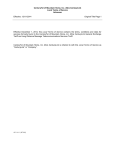
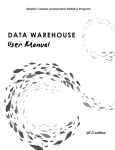
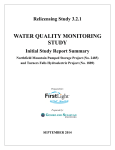
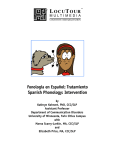
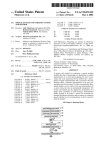
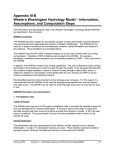
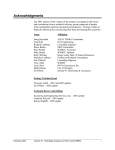
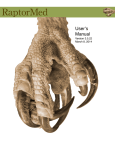
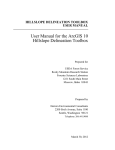
![j:j_"Xt$l"j:]:":,lg]:"r/Human Resources have been duty - e](http://vs1.manualzilla.com/store/data/005657435_1-26d97049bf04f0fd92265d73e45a9ab3-150x150.png)
